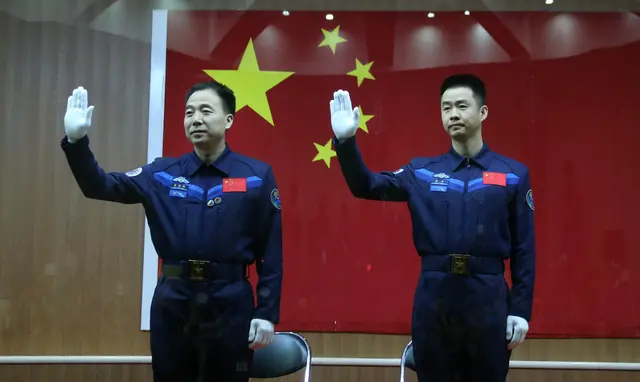The Shenzhou-11 manned spacecraft will be launched at 7:30 a.m. Monday Beijing Time, China's manned space program spokesperson said Sunday.
The spaceship will take two male astronauts Jing Haipeng and Chen Dong into space, said Wu Ping, deputy director of China's manned space engineering office, at a press conference at the Jiuquan Satellite Launch Center.
The spacecraft will dock with orbiting space lab Tiangong-2 within two days and the astronauts will stay in the space lab for 30 days before returning to Earth, the spokesperson said.
The 50-year-old Jing will be commander of the mission.It will be Jing's third spaceflight following his Shenzhou-7 mission in 2008 and Shenzhou-9 mission in 2012.
With a safe flight record of 1,500 hours as an air force pilot, Chen became China's second group of astronauts in May 2010, and was selected as a crew member of the Shenzhou-11 mission in June 2016, Wu said.
Born in central China's Henan Province in 1978, it is the first time for Chen to carry out such a mission as a crew member of China's manned spacecraft.
Jing Haipeng, one of the two astronauts who will carry out China's Shenzhou-11 mission. /Xinhua
Chen Dong, one of the two astronauts who will carry out China's Shenzhou-11 mission. /Xinhua
The mission will be carried out with a Long March-2F carrier rocket, Wu said.
The spacecraft will dock with orbiting space lab Tiangong-2 within two days, and the astronauts will stay in the space lab for 30 days, she said.
After that the Shenzhou-11 spaceship will separate with Tiangong-2 and return to Earth within one day, Wu said.
The mission aims to transport personnel and materials between Earth and Tiangong-2, and examine rendezvous, docking and return technologies.
During the mission, the spacecraft will form a complex with Tiangong-2. The complex's capabilities of supporting astronauts' life, work and health, and astronauts' abilities for carrying out flight missions will be tested, Wu said.
Other objectives include conducting aerospace medical experiments, space science experiments and in-orbit maintenance with human participation, along with activities to popularize scientific knowledge, she added.
Several technical alterations have been made to Shenzhou-11, though its main functions and technical parameters remain basically the same with Shenzhou-10, Wu said.
To meet the needs of this mission, the orbit control strategy and flight procedures have been adjusted to adapt Shenzhou-11 to the change of the rendezvous, docking and return orbit from 343 kilometers to 393 kilometers from Earth.
The layout of cargo loading has been adjusted to enhance transportation capabilities for the mission.
To further improve the spacecraft's reliability and astronauts' safety, wide-beam relay telecommunications devices have been equipped, which will significantly expand the scope of telemetry, tracking and control, as well as improve the space-ground communication support capabilities when the posture of the spacecraft is changing rapidly.
To verify future space technologies and meet the demand for prolonging the service life of rendezvous, telemetry and tracking devices in future space stations, such devices in Shenzhou-11 have been upgraded, according to Wu.
Certain technical alterations have also been made to the carrier rocket, she said.
(APD)
 简体中文
简体中文

